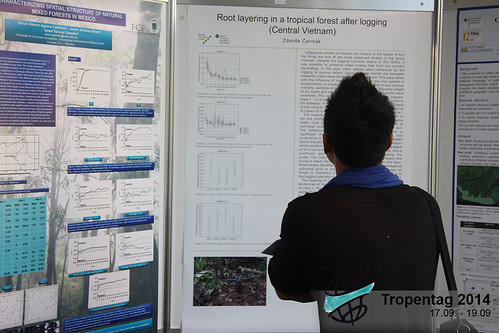sub saharan africa
Weeds, Youth and Mangos - poster session overview.
Thu, 09/18/2014 - 19:41 — Vitalii Korol Conservation agriculture (CA) has been advocated by many scientists as the solution for sustainable agricultural production. Indeed, finding of many research project support it and it can also be seen at Poster Sessions of Tropentag2014, where successful examples were given: applying no-tillage farming had a positive influence for Acrisols in Brazil, mulching application in Kenya provided better water retention or combination of technics increased yields in Mexico. However, a case study from R. Romero-Perezgrovas says, that on 6% of increase in soil fertility on the one hand, farmer would get 50% weeds in his field.
(Continue...)
Conservation agriculture (CA) has been advocated by many scientists as the solution for sustainable agricultural production. Indeed, finding of many research project support it and it can also be seen at Poster Sessions of Tropentag2014, where successful examples were given: applying no-tillage farming had a positive influence for Acrisols in Brazil, mulching application in Kenya provided better water retention or combination of technics increased yields in Mexico. However, a case study from R. Romero-Perezgrovas says, that on 6% of increase in soil fertility on the one hand, farmer would get 50% weeds in his field.
(Continue...)
Smaller and bigger – why does it matter?
Fri, 09/27/2013 - 23:34 — Louisa Wong
If a smallholder farmers in Central Africa earns an extra dollar, what kind of food would the farmer buy? The answer is - starchy staple food, fruits, meat and vegetables. If compared to a guy from a richer country like the United States, this guy would rather spend his extra dime on beverages and tobacco or dine out in a junky fast food chain to enjoy a cheeseburger with a diet coke. “The Afrint Project” is a study by from Lund University; Agnes D. was explaining in the Breakout session that her project team tries to find out the challenges faced by staple crop intensification in relation to farm sizes and urbanisation.
Domestication of soil variability in Sub-Saharan Africa: Almost there
Sat, 09/22/2012 - 14:20 — De-Registered User
Job Kihara presents a research, which tries to understand variability in crop response to fertilizer and amendments in Sub-Saharan Africa (SSA).
The objectives of the study are to identify i) soil fertility constraints to crop production, ii) the occurrence of responsive and non-responsive fields, iii) key response patterns, and iv) to identify existing links between crop response to nutrient application and soil spectra.
The research set up allows scientists to collect data on more than 400 African farms. The researchers analyse crop responses on eight fertilizer treatments.
In most sites, results show that the nutrient limitations are in order N>P>K. In acidic soils, K is as limiting as N and P. Results demonstrate a wide existence of non-responsive soils to NPK treatments compared to soil amendments consisting of lime, manure, and multi-nutrients.
In his presentation, Job Kihara only shows a tiny part of the research he is involved in. They create an amazing website containing many information on African soils explored with interactive maps. For further informations, have a look at the website of the African Soil Information Service.
Soils are like a bank account
Sat, 10/08/2011 - 12:10 — Minette Flora M... An Interview with Prof. Dr. Rattan Lal
“You cannot continue taking money out from the bank without putting it back. So improvement of soil on the basis of what has been taken out from harvesting must be replaced in a scientific manner,” stressed Prof. Dr. Rattan Lal, a distinguished university professor in soil physics and tropical soils from Ohio State University.
Either chemically or organically
“Applying manure or using bio-soil is the best option, but sometimes it is not strategically a very good option because manure requires a bulk amount. We require 10 ton/hectare of manure, which is the equivalent to100 kg of chemical fertilizer. So sometimes it is a question of logistics” he added. “A judicious combination of both organic and inorganic fertilizers is required because many times the organic matter is not adequate – it is called integrated nutrient management.”
Sub Saharan soils are marginalized
“I think Africa is the continent where the green revolution has by-passed because the soils in Sub Saharan Africa are really marginalized. They are depleted, denuded and degraded. Soil erosion and nutrient depletion of soil organic matter content have been very serious problems in Sub Saharan Africa. For sustainability, soil quality must be improved,” he concluded.
An Interview with Prof. Dr. Rattan Lal
“You cannot continue taking money out from the bank without putting it back. So improvement of soil on the basis of what has been taken out from harvesting must be replaced in a scientific manner,” stressed Prof. Dr. Rattan Lal, a distinguished university professor in soil physics and tropical soils from Ohio State University.
Either chemically or organically
“Applying manure or using bio-soil is the best option, but sometimes it is not strategically a very good option because manure requires a bulk amount. We require 10 ton/hectare of manure, which is the equivalent to100 kg of chemical fertilizer. So sometimes it is a question of logistics” he added. “A judicious combination of both organic and inorganic fertilizers is required because many times the organic matter is not adequate – it is called integrated nutrient management.”
Sub Saharan soils are marginalized
“I think Africa is the continent where the green revolution has by-passed because the soils in Sub Saharan Africa are really marginalized. They are depleted, denuded and degraded. Soil erosion and nutrient depletion of soil organic matter content have been very serious problems in Sub Saharan Africa. For sustainability, soil quality must be improved,” he concluded.




